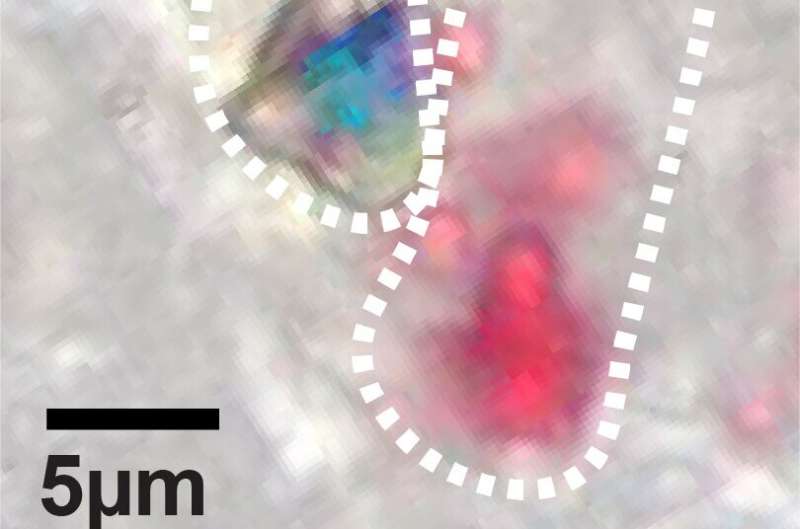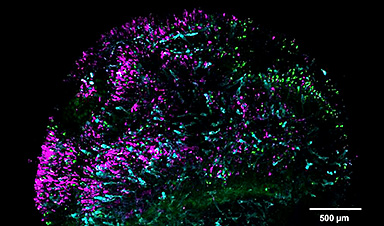With human retinas grown in a petri dish, researchers discovered how an offshoot of vitamin A generates the specialized cells that enable people to see millions of colors, an ability that dogs, cats, and other mammals do not possess.
The findings, published in PLOS Biology, increase understanding of color blindness, age-related vision loss, and other diseases linked to photoreceptor cells. They also demonstrate how genes instruct the human retina to make specific color-sensing cells, a process scientists thought was controlled by thyroid hormones.
By tweaking the cellular properties of the organoids, the research team found that a molecule called retinoic acid determines whether a cone will specialize in sensing red or green light. Only humans with normal vision and closely related primates develop the red sensor.
Scientists for decades thought red cones formed through a coin toss mechanism where the cells haphazardly commit to sensing green or red wavelengths—and research from Johnston’s team recently hinted that the process could be controlled by thyroid hormone levels. Instead, the new research suggests red cones materialize through a specific sequence of events orchestrated by retinoic acid within the eye.
The team found that high levels of retinoic acid in early development of the organoids correlated with higher ratios of green cones. Similarly, low levels of the acid changed the retina’s genetic instructions and generated red cones later in development.
“There still might be some randomness to it, but our big finding is that you make retinoic acid early in development,” Johnston said. “This timing really matters for learning and understanding how these cone cells are made.”

Green and red cone cells are remarkably similar except for a protein called opsin, which detects light and tells the brain what colors people see. Different opsins determine whether a cone will become a green or a red sensor, though the genes of each sensor remain 96% identical. With a breakthrough technique that spotted those subtle genetic differences in the organoids, the team tracked cone ratio changes over 200 days.
“Because we can control in organoids the population of green and red cells, we can kind of push the pool to be more green or more red,” said author Sarah Hadyniak, who conducted the research as a doctoral student in Johnston’s lab and is now at Duke University. “That has implications for figuring out exactly how retinoic acid is acting on genes.”
The researchers also mapped the widely varying ratios of these cells in the retinas of 700 adults. Seeing how the green and red cone proportions changed in humans was one of the most surprising findings of the new research, Hadyniak said.
Scientists still don’t fully understand how the ratio of green and red cones can vary so greatly without affecting someone’s vision. If these types of cells determined the length of a human arm, the different ratios would produce “amazingly different” arm lengths, Johnston said.
To build understanding of diseases like macular degeneration, which causes loss of light-sensing cells near the center of the retina, the researchers are working with other Johns Hopkins labs. The goal is to deepen their understanding of how cones and other cells link to the nervous system.
“The future hope is to help people with these vision problems,” Johnston said. “It’s going to be a little while before that happens, but just knowing that we can make these different cell types is very, very promising.”
Other Johns Hopkins authors include Kiara C. Eldred, Boris Brenerman, Katarzyna A. Hussey, Joanna F. D. Hagen, Rajiv C. McCoy, Michael E. G. Sauria, and James Taylor; as well as James A. Kuchenbecker, Thomas Reh, Ian Glass, Maureen Neitz, Jay Neitz of the University of Washington.
More information: Retinoic acid signaling regulates spatiotemporal specification of human green and red cones, PLoS Biology (2024). DOI: 10.1371/journal.pbio.3002464. journals.plos.org/plosbiology/ … journal.pbio.3002464
News
Novel mRNA therapy curbs antibiotic-resistant infections in preclinical lung models
Researchers at the Icahn School of Medicine at Mount Sinai and collaborators have reported early success with a novel mRNA-based therapy designed to combat antibiotic-resistant bacteria. The findings, published in Nature Biotechnology, show that in [...]
New skin-permeable polymer delivers insulin without needles
A breakthrough zwitterionic polymer slips through the skin’s toughest barriers, carrying insulin deep into tissue and normalizing blood sugar, offering patients a painless alternative to daily injections. A recent study published in the journal Nature examines [...]
Multifunctional Nanogels: A Breakthrough in Antibacterial Strategies
Antibiotic resistance is a growing concern - from human health to crop survival. A new study successfully uses nanogels to target and almost entirely inhibit the bacteria P. Aeruginosa. Recently published in Angewandte Chemie, the study [...]
Nanoflowers rejuvenate old and damaged human cells by replacing their mitochondria
Biomedical researchers at Texas A&M University may have discovered a way to stop or even reverse the decline of cellular energy production—a finding that could have revolutionary effects across medicine. Dr. Akhilesh K. Gaharwar [...]
The Stunning New Push to Protect the Invisible 99% of Life
Scientists worldwide have joined forces to build the first-ever roadmap for conserving Earth’s vast invisible majority—microbes. Their new IUCN Specialist Group reframes conservation by elevating microbial life to the same urgency as plants and [...]
Scientists Find a Way to Help the Brain Clear Alzheimer’s Plaques Naturally
Scientists have discovered that the brain may have a built-in way to fight Alzheimer’s. By activating a protein called Sox9, researchers were able to switch on star-shaped brain cells known as astrocytes and turn them into [...]
Vision can be rebooted in adults with amblyopia, study suggests
Temporarily anesthetizing the retina briefly reverts the activity of the visual system to that observed in early development and enables growth of responses to the amblyopic eye, new research shows. In the common vision [...]
Ultrasound-activated Nanoparticles Kill Liver Cancer and Activate Immune System
A new ultrasound-guided nanotherapy wipes out liver tumors while training the immune system to keep them from coming back. The study, published in Nano Today, introduces a biodegradable nanoparticle system that combines sonodynamic therapy and cell [...]
Magnetic nanoparticles that successfully navigate complex blood vessels may be ready for clinical trials
Every year, 12 million people worldwide suffer a stroke; many die or are permanently impaired. Currently, drugs are administered to dissolve the thrombus that blocks the blood vessel. These drugs spread throughout the entire [...]
Reviving Exhausted T Cells Sparks Powerful Cancer Tumor Elimination
Scientists have discovered how tumors secretly drain the energy from T cells—the immune system’s main cancer fighters—and how blocking that process can bring them back to life. The team found that cancer cells use [...]
Very low LDL-cholesterol correlates to fewer heart problems after stroke
Brigham and Women's Hospital's TIMI Study Group reports that in patients with prior ischemic stroke, very low achieved LDL-cholesterol correlated with fewer major adverse cardiovascular events and fewer recurrent strokes, without an apparent increase [...]
“Great Unified Microscope” Reveals Hidden Micro and Nano Worlds Inside Living Cells
University of Tokyo researchers have created a powerful new microscope that captures both forward- and back-scattered light at once, letting scientists see everything from large cell structures to tiny nanoscale particles in a single shot. Researchers [...]
Breakthrough Alzheimer’s Drug Has a Hidden Problem
Researchers in Japan found that although the Alzheimer’s drug lecanemab successfully removes amyloid plaques from the brain, it does not restore the brain’s waste-clearing system within the first few months of treatment. The study suggests that [...]
Concerning New Research Reveals Colon Cancer Is Skyrocketing in Adults Under 50
Colorectal cancer is striking younger adults at alarming rates, driven by lifestyle and genetic factors. Colorectal cancer (CRC) develops when abnormal cells grow uncontrollably in the colon or rectum, forming tumors that can eventually [...]
Scientists Discover a Natural, Non-Addictive Way To Block Pain That Could Replace Opioids
Scientists have discovered that the body can naturally dull pain through its own localized “benzodiazepine-like” peptides. A groundbreaking study led by a University of Leeds scientist has unveiled new insights into how the body manages pain, [...]
GLP-1 Drugs Like Ozempic Work, but New Research Reveals a Major Catch
Three new Cochrane reviews find evidence that GLP-1 drugs lead to clinically meaningful weight loss, though industry-funded studies raise concerns. Three new reviews from Cochrane have found that GLP-1 medications can lead to significant [...]





















